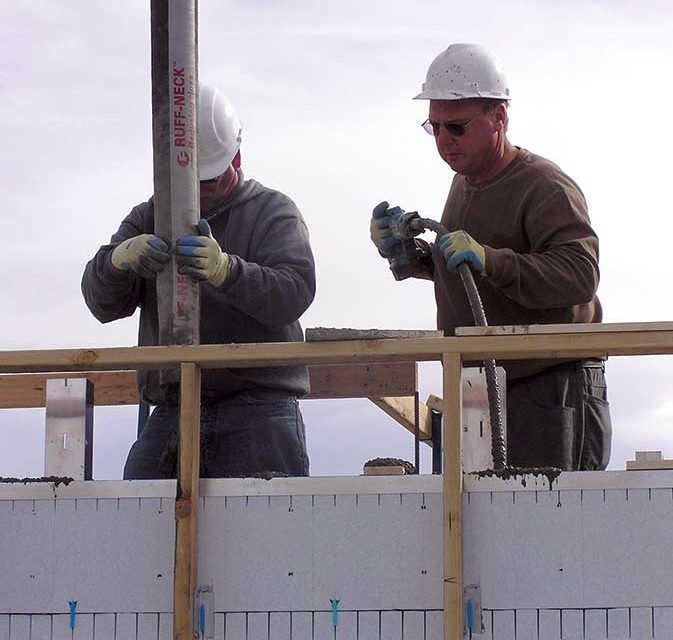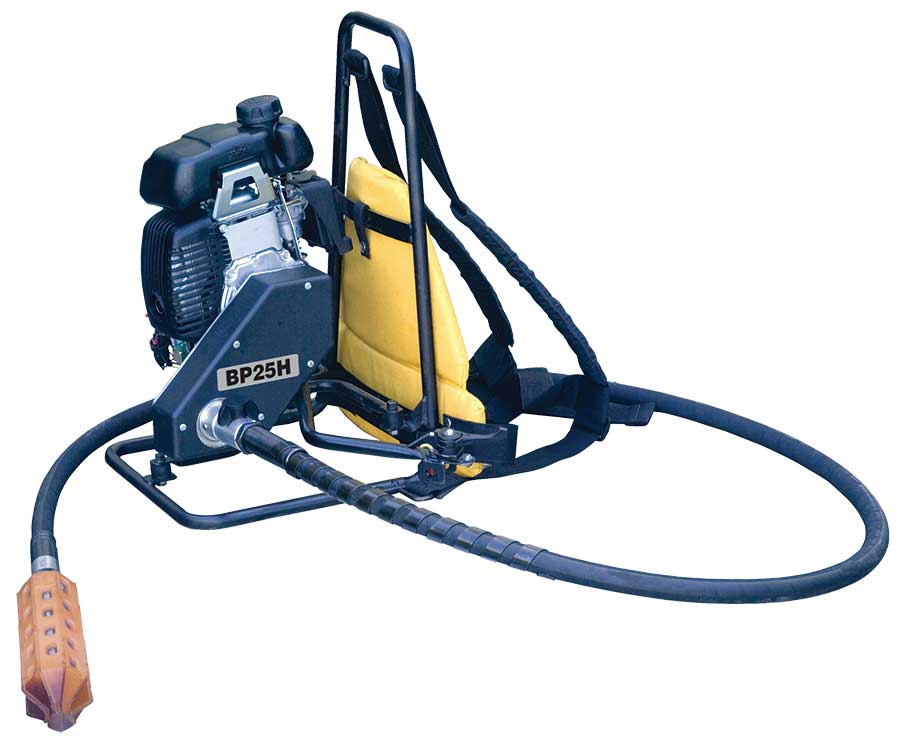Good concrete consolidation is essential for strong, energy-efficient ICF walls.
Voids and honeycombing can create basement leaks, and in extreme cases, affect the structural integrity of the walls. Ironically, corners and lintels—the areas that need the most strength—are the areas where poor consolidation is most likely to occur. Form pressures are highest in these two areas, so some builders don’t vibrate them as thoroughly. However, these critical areas need more vibration—not less—due to the congestion caused by extra reinforcing steel.
How much vibration does a wall need, and what is the best way to do it? Every contractor has his preferred option. Some pound on the outside of the wall with a 2×4. Others use a reciprocating saw or orbital sander. Internal “pencil” vibrators are extremely popular, and one manufacturer offers a rebar shaker that reportedly works well.
Guy Rosenlof, a California-based ICF contractor, claims “proper vibration” is somewhat dependant on form type. “Some early ICF designs can’t handle excessive vibration,” he cautions. “Either strike the outside of the wall with a 2×4 or vibrate minimally.” Newer designs are stronger, but still need care. “Brace the hell out of the corners,” he recommends. “Lintels don’t have the two directions of force, but the corners need extra bracing.”
Several years ago, the Portland Cement Association (PCA) conducted an in-depth study of concrete consolidation and ICFs. They tested flat panels with 4- and 6-inch cores, as well as a screen grid and waffle grid ICFs. Panels with corners and lintels were also tested. (See chart below). Panels were filled with low- (3”), medium- (6”) and high-slump (8”-10”) concrete and vibrated with wood blocks, saws, sanders, and internal vibrators. They also filled test panels with a self-consolidating concrete (SCC).
The conclusion? Low slump walls had poor consolidation, regardless of the technique used. “External mechanical vibration using a hammer, reciprocating saw, or orbital sander did not significantly improve the consolidation of concrete in ICF walls…” the report states. Operators could, however, detect large voids beneath the foam by listening to slight changes in the sound.
On the medium slump panels, external vibration scored slightly better, but not nearly as well a vibrator. “Internal vibration was found to provide adequate consolidation for concrete with a slump of 6 inches or greater. In areas of high rebar congestion, such as lintels and corners, caution must be used in order to achieve adequate consolidation… As an alternative to internal vibration, adequate consolidation also was achieved through the use of a flowable, high-slump concrete.”
The entire report, titled Concrete Consolidation and the Potential for Voids in ICF Walls, is available at our website:
www.icfmag.com.
“The primary advantage of internal vibration is that it’s more consistent,” says Jeff Carcanagues, sales manager at Dreyer Vibrator.
It’s also cheaper. Fred Oswald, president of Oztec Industries, says self-consolidating concrete can be about twice as expensive as regular mixes. “And the forms have to be almost watertight to hold the mix,” he adds.
Oswald and Carcanagues agree that getting good consolidation is a combination of the right equipment and an experienced operator.
“We recommend the pencil head [3/4 inch diameter] for ICFs and the 1 1/8 inch head for the larger forms,” Carcanagues says. “It depends on the width of the form and the slump of the concrete. If it’s a wet mix, say 6- or 7-inch slump, we’ll use the pencil head. A stiff mix with a 3-4 inch slump needs a bigger head. The biggest thing about internal vibration is technique. Its not just dragging it through the concrete,” he states.
The vibrator should be inserted vertically into the mix, then slowly withdrawn. If the wall is poured in multiple lifts, the vibrator tip should go deep enough to penetrate 3 to 6 in. into the previous layer.
Vibrators work by allowing air to float up and out of the concrete, so the tip should not be withdrawn faster than the air can move upward, about 3 inches per second.
Each particular vibrator head has a “zone of influence” where consolidation is occurring. “The vibrator should be inserted so that the zone of influence of successive passes overlap so that all areas of the concrete are properly consolidated,” notes the PCA report. The zone of influence is larger with high-slump mixes. “It has to be done very systematically,” Oswald states.
Carcanagues says the easiest thing to do is to look at the mix. “You’ll be able to see [the radius of influence] because it’ll have sheen to it.”
Another option is Oztec’s rebar shaker. It uses the same engine as the internal vibrator, but works by attaching to the top of the vertical rebar, effectively converting the entire steel rod into a vibrator. “The rebar shaker will give you very good results if the rebar is fairly close together, about 12 or 14 inches,” Oswald says. “If everything is tied together, it will vibrate the horizontal rebar as well.” At wider spacings, it needs to be augmented by a pencil vibrator. He notes that this method produces excellent bonding to the rebar, and is great for congested areas—like lintels—that would be hard to get a pencil vibrator into.
Good concrete consolidation is not complicated. Exact specifications will vary from job to job, but by observing a few general rules, you’ll be able to achieve a strong, well-consolidated wall every time. First, use a concrete mix with a slump of at least 6 inches. Second, brace corners and lintels well and vibrate them thoroughly. Lastly, a trained operator should use a vibrator to consolidate the mix as recommended by your form manufacturer.
“The important thing is to get vibration into every part of the concrete,” says Oswald.














